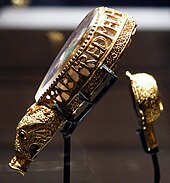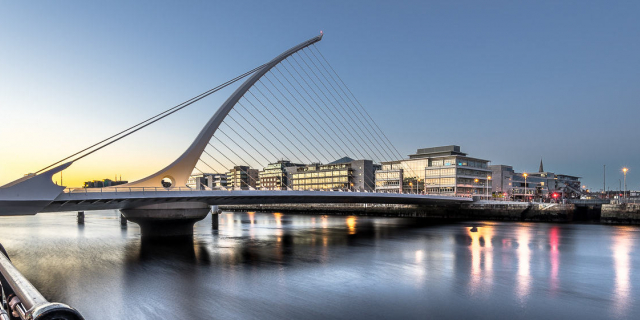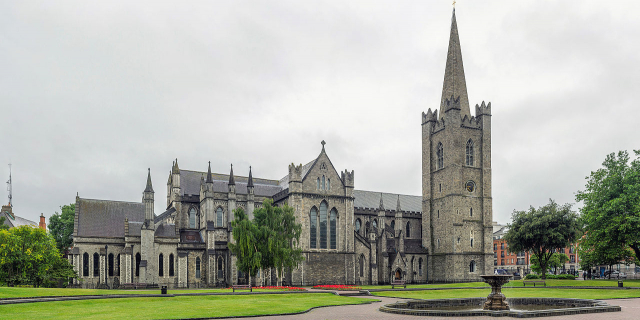British Isles
Context of British Isles
The British Isles are a group of islands in the North Atlantic Ocean off the north-western coast of continental Europe, consisting of the islands of Great Britain, Ireland, the Isle of Man, the Inner and Outer Hebrides, the Northern Isles, and over six thousand smaller islands. They have a total area of 315,159 km2 (121,684 sq mi) and a combined population of almost 72 million, and include two sovereign states, the Republic of Ireland (which covers roughly five-sixths of Ireland), and the United Kingdom of Great Britain and Northern Ireland. The Channel Islands, off the north coast of France, are normally taken to be part of the British Isles, even though they do not form part of the archipelago.
The oldest rocks are 2.7 billion years old and are found in Ireland, Wales and the northwest of Scotland. During the Silurian period, the north-western regions collided with the south-east, which had been part of a separate continental...Read more
The British Isles are a group of islands in the North Atlantic Ocean off the north-western coast of continental Europe, consisting of the islands of Great Britain, Ireland, the Isle of Man, the Inner and Outer Hebrides, the Northern Isles, and over six thousand smaller islands. They have a total area of 315,159 km2 (121,684 sq mi) and a combined population of almost 72 million, and include two sovereign states, the Republic of Ireland (which covers roughly five-sixths of Ireland), and the United Kingdom of Great Britain and Northern Ireland. The Channel Islands, off the north coast of France, are normally taken to be part of the British Isles, even though they do not form part of the archipelago.
The oldest rocks are 2.7 billion years old and are found in Ireland, Wales and the northwest of Scotland. During the Silurian period, the north-western regions collided with the south-east, which had been part of a separate continental landmass. The topography of the islands is modest in scale by global standards. Ben Nevis, the highest mountain, rises to only 1,345 metres (4,413 ft), and Lough Neagh, which is notably larger than other lakes in the island group, covers 390 square kilometres (151 sq mi). The climate is temperate marine, with cool winters and warm summers. The North Atlantic drift brings significant moisture and raises temperatures 11 °C (20 °F) above the global average for the latitude. This led to a landscape that was long dominated by temperate rainforest, although human activity has since cleared the vast majority of forest cover. The region was re-inhabited after the last glacial period of Quaternary glaciation, by 12,000 BC, when Great Britain was still part of a peninsula of the European continent. Ireland was only connected to Great Britain by way of an ice bridge ending by 14,000 BC, and was not inhabited until after 8000 BC. Great Britain became an island by 7000 BC with the flooding of Doggerland.
The Hiberni (Ireland), Picts (northern Great Britain) and Britons (southern Great Britain), all speaking Insular Celtic languages, inhabited the islands at the beginning of the 1st millennium BC. Much of Brittonic-occupied Britain was conquered by the Roman Empire from AD 43. The first Anglo-Saxons arrived as Roman power waned in the 5th century, and eventually they dominated the bulk of what is now England. Viking invasions began in the 9th century, followed by more permanent settlements and political change, particularly in England. The Norman conquest of England in 1066 and the later Angevin partial conquest of Ireland from 1169 led to the imposition of a new Norman ruling elite across much of Britain and parts of Ireland. By the Late Middle Ages, Great Britain was separated into the Kingdom of England and Kingdom of Scotland, while control in Ireland fluxed between Gaelic kingdoms, Hiberno-Norman lords and the English-dominated Lordship of Ireland, soon restricted only to The Pale. The 1603 Union of the Crowns, Acts of Union 1707 and Acts of Union 1800 aimed to consolidate Great Britain and Ireland into a single political unit, the United Kingdom of Great Britain and Ireland, with the Isle of Man and the Channel Islands remaining as Crown Dependencies. The expansion of the British Empire and migrations following the Irish Famine and Highland Clearances resulted in the dispersal of some of the islands' population and culture throughout the world, and rapid depopulation of Ireland in the second half of the 19th century. Most of Ireland seceded from the United Kingdom after the Irish War of Independence and the subsequent Anglo-Irish Treaty (1919–1922), with six counties remaining in the UK as Northern Ireland.
In Ireland, the term "British Isles" is controversial, and there are objections to its usage. The Government of Ireland does not officially recognise the term, and its embassy in London discourages its use. "Britain and Ireland" is used as an alternative description, and "Atlantic Archipelago" has also seen limited use in academia. In official documents created jointly by Ireland and the United Kingdom, such as the Good Friday Agreement, the term "these islands" is used.
More about British Isles
- Population 71891524
- Area 121684
- This section needs additional citations for verification. (January 2023)This section may need to be rewritten to comply with Wikipedia's quality standards.Read lessThis section needs additional citations for verification. (January 2023)This section may need to be rewritten to comply with Wikipedia's quality standards. (August 2021)
2.5 million years ago the British Isles were repeatedly submerged beneath an ice sheet which extended into the middle of the North Sea, with a larger ice sheet that covered a significant proportion of Scandinavia on the opposite side. Around 1.9 million years ago these two ice sheets frequently merged, essentially creating a land bridge between Scandinavia and northern Great Britain.[1] Further south, there was a direct land bridge, now known as Doggerland, which was gradually submerged as sea levels rose.[2][3] However, the Irish Sea was formed before Doggerland was completely covered in water, with Ireland becoming an island roughly 6,000 years before Great Britain did.[4]
At the time of the Roman Empire, about two thousand years ago, various tribes, which spoke Celtic dialects of the Insular Celtic group, were inhabiting the islands. The Romans expanded their civilisation to control southern Great Britain but were impeded in advancing any further, building Hadrian's Wall to mark the northern frontier of their empire in 122 AD. At that time, Ireland was populated by a people known as Hiberni, the northern third or so of Great Britain by a people known as Picts and the southern two thirds by Britons.
 The Alfred Jewel (9th century)
The Alfred Jewel (9th century)Anglo-Saxons arrived as Roman power waned in the 5th century AD. Initially, their arrival seems to have been at the invitation of the Britons as mercenaries to repulse incursions by the Hiberni and Picts. In time, Anglo-Saxon demands on the British became so great that they came to culturally dominate the bulk of southern Great Britain, though recent genetic evidence suggests Britons still formed the bulk of the population. This dominance created what is now England and left culturally British enclaves only in the north of what is now England, in Cornwall and what is now known as Wales. Ireland had been unaffected by the Romans except, significantly, for being Christianised—traditionally by the Romano-Briton, Saint Patrick. As Europe, including Britain, descended into turmoil following the collapse of Roman civilisation, an era known as the Dark Ages, Ireland entered a golden age and responded with missions (first to Great Britain and then to the continent), the founding of monasteries and universities. These were later joined by Anglo-Saxon missions of a similar nature.
Viking invasions began in the 9th century, followed by more permanent settlements, particularly along the east coast of Ireland, the west coast of modern-day Scotland and the Isle of Man. Though the Vikings were eventually neutralised in Ireland, their influence remained in the cities of Dublin, Cork, Limerick, Waterford and Wexford. England, however, was slowly conquered around the turn of the first millennium AD, and eventually became a feudal possession of Denmark. The relations between the descendants of Vikings in England and counterparts in Normandy, in northern France, lay at the heart of a series of events that led to the Norman conquest of England in 1066. The remnants of the Duchy of Normandy, which conquered England, remain associated to the English Crown as the Channel Islands to this day. A century later, the marriage of the future Henry II of England to Eleanor of Aquitaine created the Angevin Empire, partially under the French Crown. At the invitation of Diarmait Mac Murchada, a provincial king, and under the authority of Pope Adrian IV (the only Englishman to be elected pope), the Angevins invaded Ireland in 1169. Though initially intended to be kept as an independent kingdom, the failure of the Irish High King to ensure the terms of the Treaty of Windsor led Henry II, as King of England, to rule as effective monarch under the title of Lord of Ireland. This title was granted to his younger son, but when Henry's heir unexpectedly died, the title of King of England and Lord of Ireland became entwined in one person.
 James VI of Scotland (James I of England)
James VI of Scotland (James I of England)By the Late Middle Ages, Great Britain was separated into the Kingdoms of England and Scotland. Power in Ireland fluxed between Gaelic kingdoms, Hiberno-Norman lords and the English-dominated Lordship of Ireland. A similar situation existed in the Principality of Wales, which was slowly being annexed into the Kingdom of England by a series of laws. During the course of the 15th century, the Crown of England would assert a claim to the Crown of France, thereby also releasing the King of England from being vassal of the King of France. In 1534, King Henry VIII, at first having been a strong defender of Roman Catholicism in the face of the Reformation, separated from the Roman Church after failing to secure a divorce from the Pope. His response was to place the King of England as "the only Supreme Head in Earth of the Church of England", thereby removing the authority of the Pope from the affairs of the English Church. Ireland, which had been held by the King of England as Lord of Ireland, but which strictly speaking had been a feudal possession of the Pope since the Norman invasion was declared a separate kingdom in personal union with England.
Scotland meanwhile had remained an independent Kingdom. In 1603, that changed when the King of Scotland inherited the Crown of England, and consequently the Crown of Ireland also. The subsequent 17th century was one of political upheaval, religious division and war. English colonialism in Ireland of the 16th century was extended by large-scale Scottish and English colonies in Ulster. Religious division heightened and the king in England came into conflict with parliament over his tolerance towards Catholicism. The resulting English Civil War or War of the Three Kingdoms led to a revolutionary republic in England. Ireland, largely Catholic was mainly loyal to the king, but by military conquest was subsumed into the new republic. Following defeat to the parliament's army, large scale land distributions from loyalist Irish nobility to English commoners in the service of the parliamentary army created a new Ascendancy class which obliterated the remnants of Old English (Hiberno-Norman) and Gaelic Irish nobility in Ireland. The new ruling class was Protestant and English, whilst the populace was largely Catholic and Irish. This theme would influence Irish politics for centuries to come. When the monarchy was restored in England, the king found it politically impossible to restore the lands of former landowners in Ireland. The "Glorious Revolution" of 1688 repeated similar themes: a Catholic king pushing for religious tolerance in opposition to a Protestant parliament in England. The king's army was defeated at the Battle of the Boyne and at the militarily crucial Battle of Aughrim in Ireland. Resistance held out, eventually forcing the guarantee of religious tolerance in the Treaty of Limerick. However, the terms were never honoured and a new monarchy was installed.
The Kingdoms of England and Scotland were unified in 1707 creating the Kingdom of Great Britain. Following an attempted republican revolution in Ireland in 1798, the Kingdoms of Ireland and Great Britain were unified in 1801, creating the United Kingdom. The Isle of Man and the Channel Islands remaining outside of the United Kingdom but with their ultimate good governance being the responsibility of the British Crown (effectively the British government). Although the colonies of North America that would become the United States of America were lost by the start of the 19th century, the British Empire expanded rapidly elsewhere. A century later it would cover one-third of the globe. Poverty in the United Kingdom remained desperate, however, and industrialisation in England led to terrible conditions for the working classes. Mass migrations following the Irish Famine and Highland Clearances resulted in the distribution of the islands' population and culture throughout the world and a rapid de-population of Ireland in the second half of the 19th century. Most of Ireland seceded from the United Kingdom after the Irish War of Independence and the subsequent Anglo-Irish Treaty (1919–1922), with the six counties that formed Northern Ireland remaining as an autonomous region of the UK.
^ "New research reveals British Isles buried under ice sheets 2.5 million years ago". New research reveals British Isles buried under ice sheets 2.5 million years ago. Retrieved 6 January 2023. ^ Magazine, Smithsonian; McGreevy, Nora. "Study Rewrites History of Ancient Land Bridge Between Britain and Europe". Smithsonian Magazine. Retrieved 6 January 2023. ^ "The making of an island". www.nhm.ac.uk. Retrieved 6 January 2023. ^ "Prehistoric Ireland - Formation Of An Island - About History". Retrieved 6 January 2023.



































